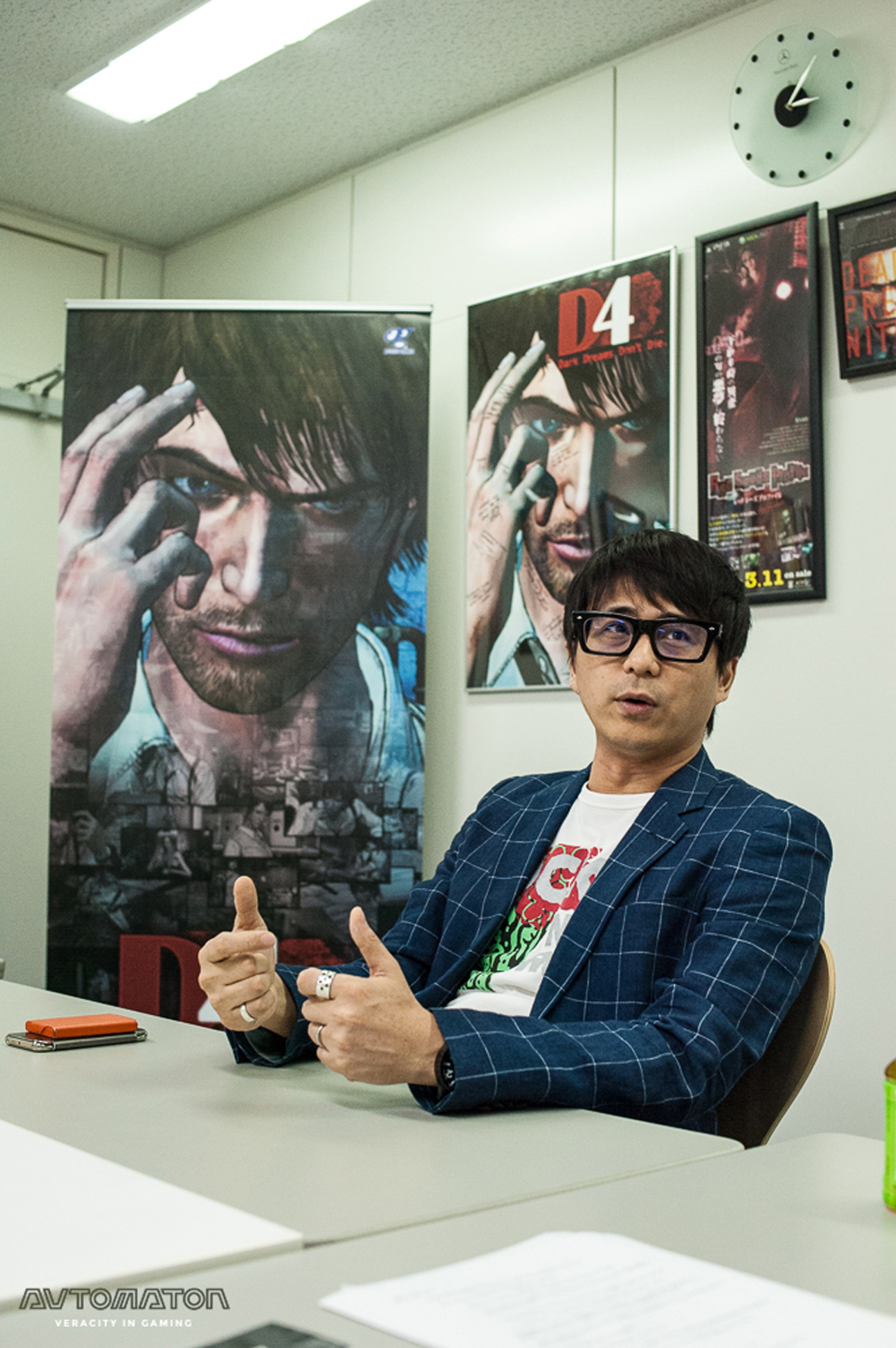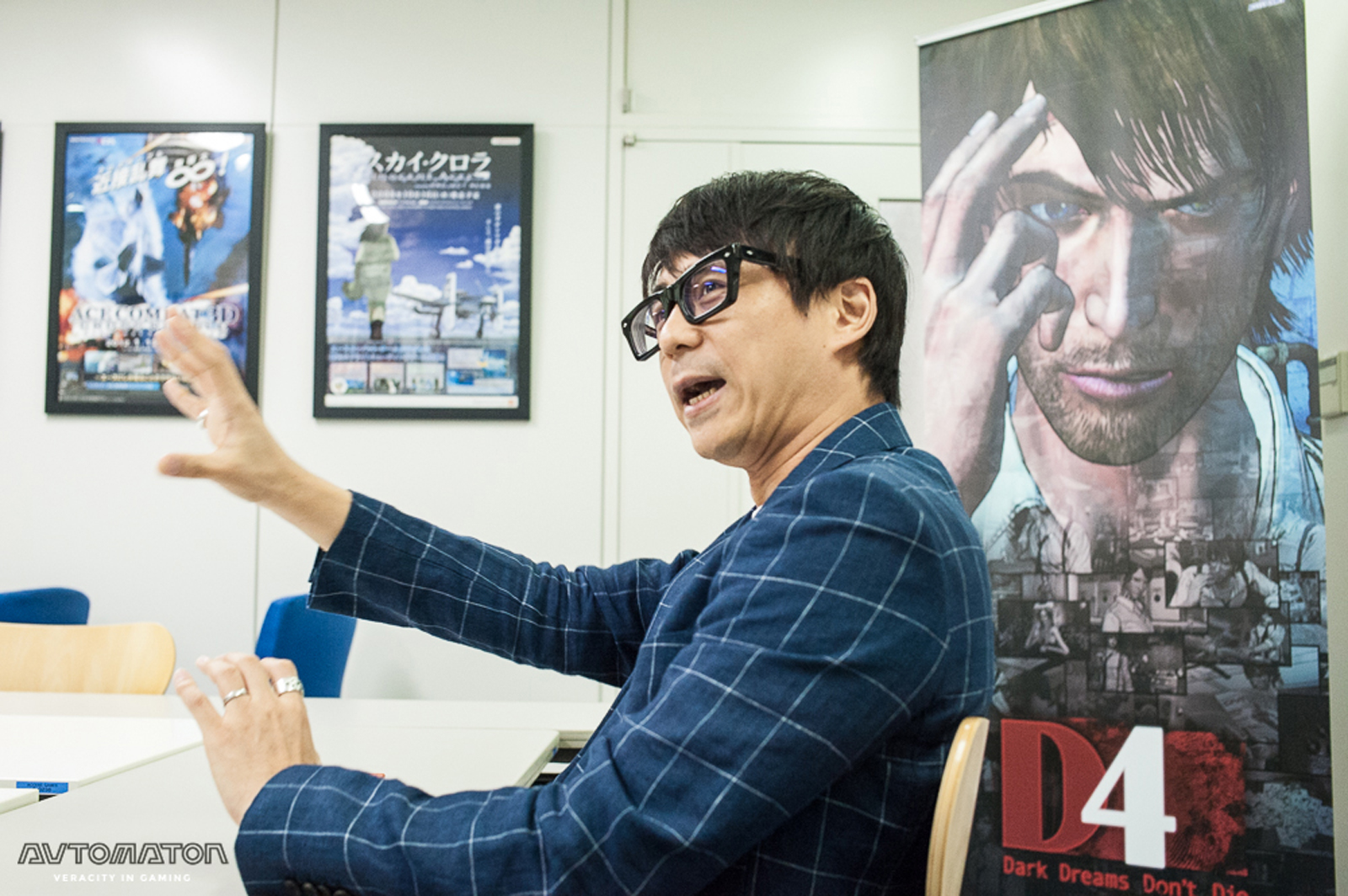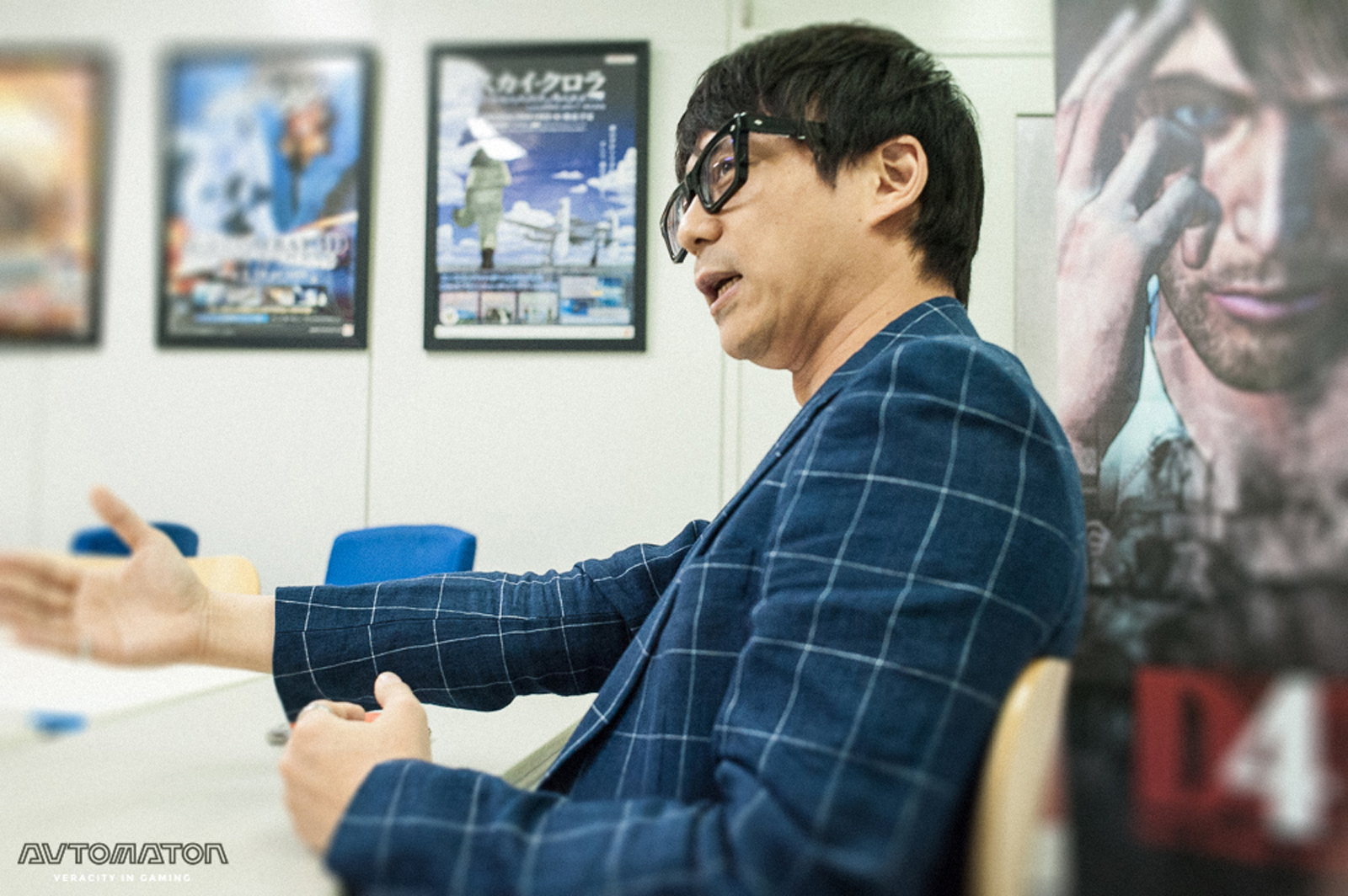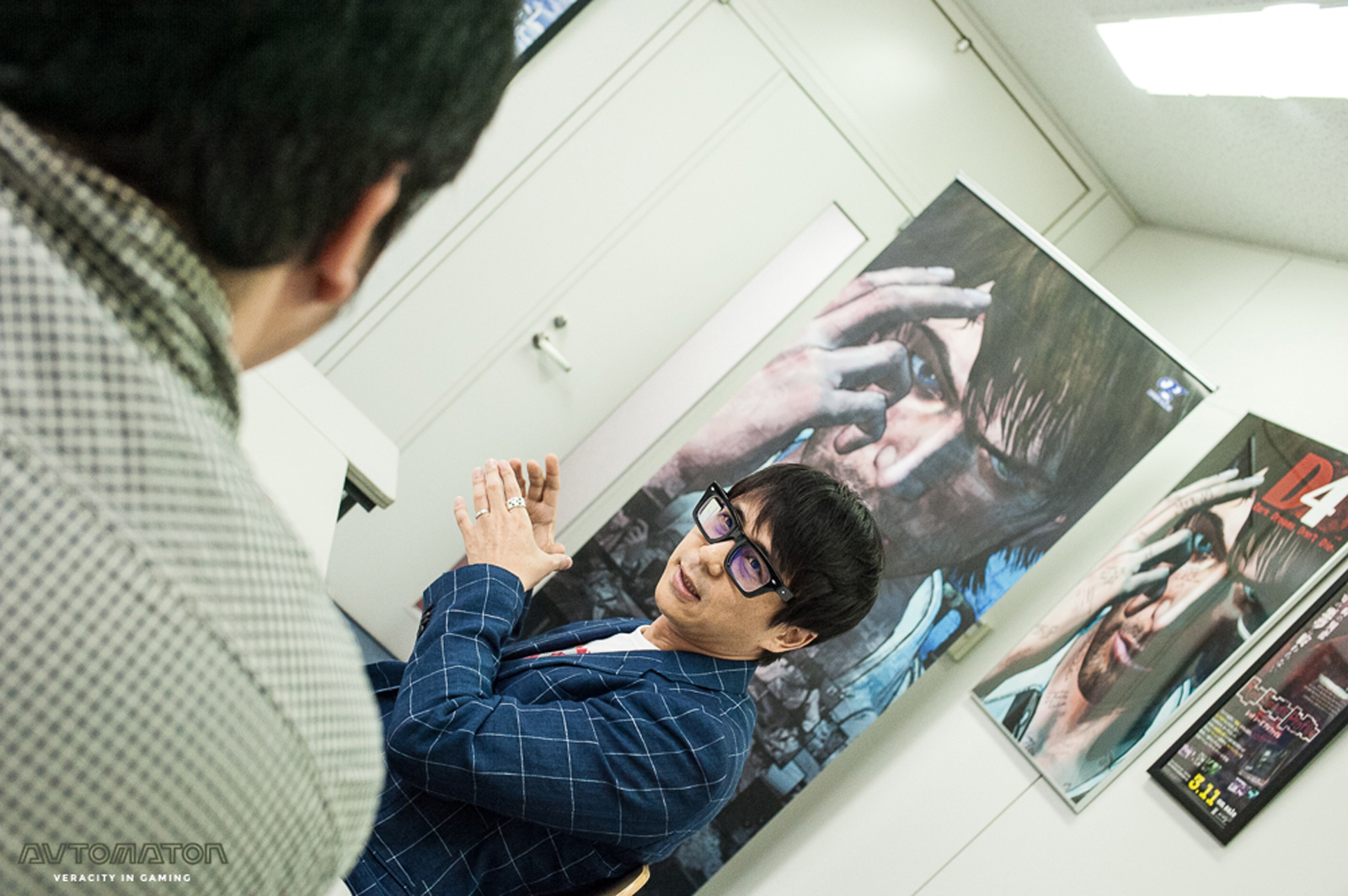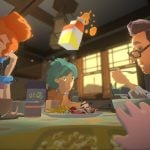Interview: SWERY (Access Games) – How The PC Version of D4 Was Made
こちらの記事は、PC版『D4: Dark Dreams Don't Die -Season One-』の発売直前に開発元のアクセスゲームズを取材した記事「アクセスゲームズSWERY、PC版『D4』発売インタビュー[前編]」の英語版です。
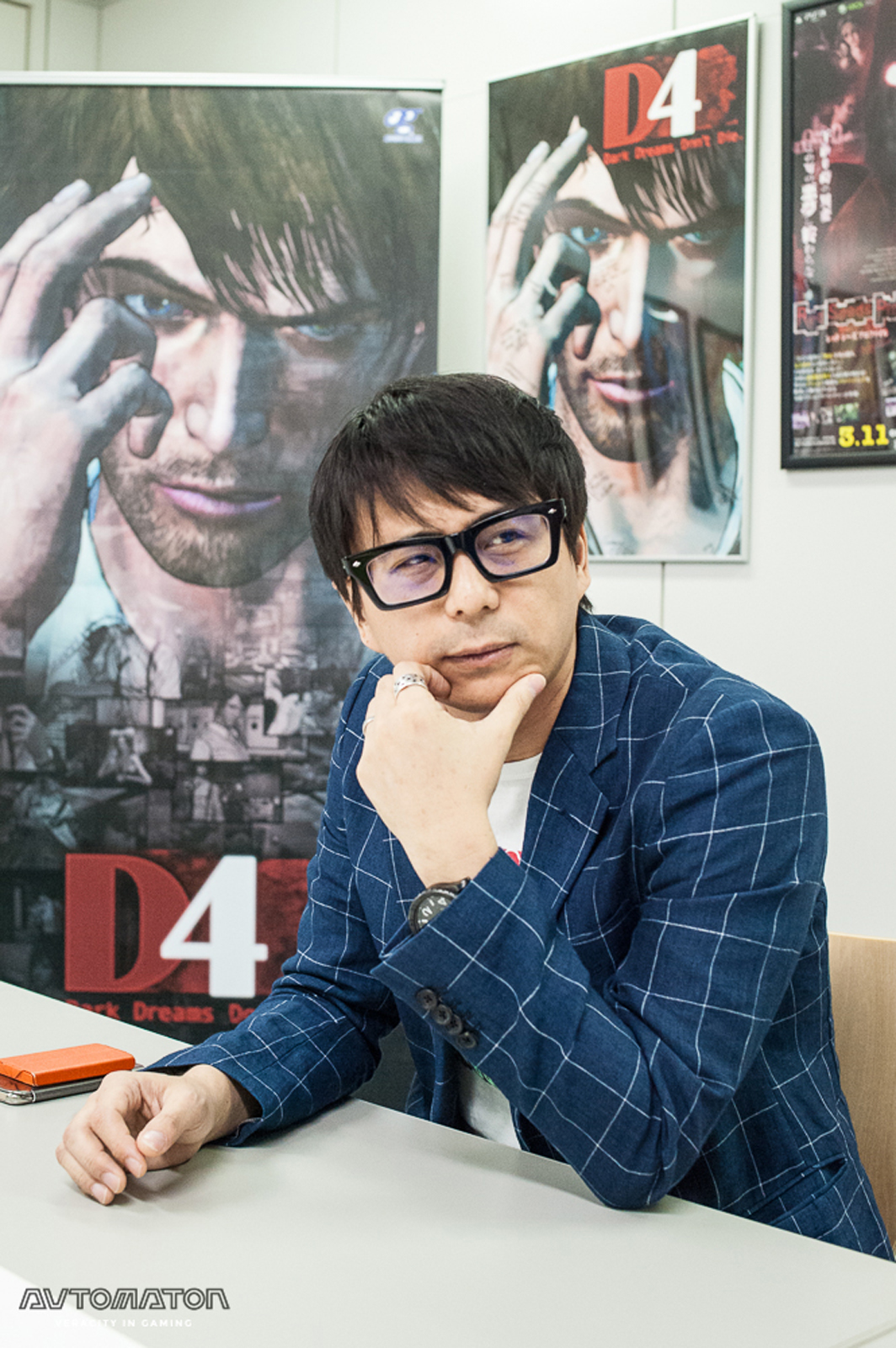
こちらの記事は、PC版『D4: Dark Dreams Don’t Die -Season One-』の発売直前に開発元のアクセスゲームズを取材した記事「アクセスゲームズSWERY、PC版『D4』発売インタビュー[前編]」の英語版です。日本語版はこちらになります。
On June 6th, 2015, PLAYISM will release the PC version of D4: Dark Dreams Don’t Die (Season 1) on both the Steam and PLAYISM platforms, with a $14.99 price tag. The trial version is also currently available for download through PLAYISM.
D4 is the latest title from Japanese developer SWERY who enjoyed a deep cult following thanks to his previous title, Deadly Premonition (known as “Red Seeds Profile” in Japan). The PC port follows the original Xbox One version, which was released in 2014. So how did the PC version of D4 come to be released? We spoke to SWERY himself about this very question as well as some of the themes in the game and what it was like during development.
Development lasted over three years
SWERY:
I checked out your renewed site, it looks pretty serious, huh?
――[Laughs] Yeah, we thought we’d take it a bit more seriously… We’re trying to dig deep and keep it nice and serious at the same time.
SWERY:
[Laughs] Well, interviews tend to carry a lot of text, but like… If I say I’m not answering seriously, that sounds kinda, you know… But I always try to write so that the readers will find it funny and interesting. But anyway, this time I’d like to actually answer seriously. [Laughs]
――[Laughs] OK then, first off we’d like to talk to you about D4 itself. Could you give our readers a bit of a quick primer about exactly what kind of title D4 is?
SWERY:
D4 is about a private detective with special powers who uses these powers to go back and forth between the past and the present in an attempt to track down the person who murdered his wife two years prior. It’s a mystery/adventure title in which you try to solve the mystery of your wife’s death. We adhere to two main concepts for the game: “sensory replication” and “empathy”; originally with the Xbox One version, we wanted to use the Kinect device to replicate the user’s senses, and by doing that we wanted to design a game that would allow the user to feel even more immersed in and feel more empathy towards the story. As for the upcoming PC version, we took what used to be the Kinect controls and redesigned them as to be optimized for easy, single-hand play using the mouse, while making sure to once again properly reproduce the sense that you’re really inside the world of the game, and that you’re feeling and sensing something. That’s the PC version of D4.
――Could you fill us in on the circumstances leading up to the development of D4? First, we’ve got the Xbox One version, released in 2014.
SWERY:
Um, when did it start again…? I gave a lecture on Red Seeds Profile/Deadly Premonition at GDC 2011, and at that time I’d already had the “sensory replication” and “empathy” keywords up in my brains, which I used to speak with a bunch of different companies. At the time, Kinect had already started gaining a following on the Xbox 360, and I believe it all started with my going to Microsoft and pitching them the idea of possibly using that for the “sensory replication” thing. So we designed the game on the Xbox 360, and we had actually even started producing the game, but at that point the Kinect wasn’t able to pick up on the shape of the user’s hand. So we started writing code ourselves and made something up that was able to recognize the “rock” and “paper” gestures, then we made up a sample, and it really started coming into shape. Since it was right around the time when Kinect was about to be renewed and the Xbox One was going to come out, we upgraded and redid the whole thing for the Xbox One. We added more and more recognitions and changed things up a bit to make it even easier to play, and that’s how things sort of took shape from the very beginning.
――So including the initial idea for the game, altogether that’s about a three-year development period, right?
SWERY:
Yeah. The other day one of the producers was saying that it was about 40 months in total, but that’s just for the Xbox One version alone.
――40 months…
SWERY:
Yeah, it’s a long time.
“High-end” doesn’t necessarily equal “difficult”
――What were your reasons for selecting the Kinect as the device you wanted to use for your “sensory replication” idea?
SWERY:
Video games keep getting better and better graphics, and they keep getting more and more high-end, right? And doesn’t that kind of give the impression that “the better something looks, the more difficult it must be”? For example, when you look at a Western game and it’s got really high-end graphics, when you think about actually playing it, you’re like, “This game must be hard…”, or “It’s probably got lots of stuff I’ll have to work really hard at…” or whatever. So I wanted to, like, fill in that gap, or more like I wanted to make something that looked really high-end and high-grade, but with casual gameplay―something that you could play really casually while relaxing, like while sitting on the sofa and watching TV or something like that.
But a game is ultimately judged on its gameplay. My strategy was not to make the sort of game where you have to press a bunch of buttons, but one that by reproducing the player’s senses makes you feel like you’ve accomplished the same amount as you would have by pressing all those buttons… It sounds funky, but I came up with this methodology, and just sort of tried it out.
I wanted to allow the player to relax while playing, but “relaxing while playing” generally means that there are less operations to be executed, I guess. I started feeling like, with less controls and operations, a game feels like less of a “game”, you know? So instead of that, it’s like, you’re controlling the game comfortably―you’re controlling a high-end game comfortably―but you’re relaxing. You’re not pressing hella buttons, but you’re having fun―this is the sort of game I wanted to make, and that’s where it all started. So as far as methodology goes, the “sensory replication” concept became really important to me.

――I played D4 myself, and I really felt that while each individual action is really simple, it’s fun to play, and you really get a sense of fulfillment. Was there anything you specifically did during development to sort of ensure this?
SWERY:
Well, there are several things, but first, when using Kinect or other motion control devices, everyone always wants to get people to imitate specific poses, right? They tend to think that players will have the most fun by striking poses to imitate whatever is going on on the screen, you know? Pose like this if you’re shooting a gun, et cetera. Instead of that, I wanted to create a symbol inside the user’s head that would represent the action they’re supposed to be performing, and then simplify that represented action. And if you don’t allow the user to perform those actions in a simple manner, then you’re basically just showing a rendered version of what’s actually going on inside the game, and the reward you get for your actions (or, “input”, rather) is reduced. Normally, you move the joystick and press a button and you see something happen, but when it becomes necessary to strike a pose in order to see the same thing, you feel like the reward you get for the effort you’ve put out feels sort of lacking, so making sure to keep that proper balance was another really important point.
At first, everything was about poses―opening doors had to be done with a door-opening action; avoiding people had to be done like this; all kinds of stuff. Picking up and throwing objects, whatever. But the result of actually throwing something is happening in the game, except it’s not―I mean, like playing catch by actually throwing a ball is definitely more fun. While playing catch in the park for reals is fun, acting like you’re playing catch in a game―even if something awesome happens because of it―just feels lacking. So instead of that, from the very start I decided that control input had to be made more simple, and we had to try that out before anything else before we knew how it would work out.
So that ended up coming into shape, and once we tried making the game with simple control input, there was a whole mess of actions the player might want to try inputting. For example, when an opponent throws a punch at you, some people jump out of the way to avoid it, and others dodge it like this, and some people throw a punch back, right?
――I see.
SWERY:
In this situation, we really want to see a punch thrown in return, within the “drama”. So as for what to do about this, once the player sees that a punch is coming at their character, they input their command like right at the last second as they recognize from the screen that it’s coming. By doing this, the user inputs their command after first realizing, “Oh, so I’m supposed to punch here,” and so instead of feeling like they’re being forced to do everything, the user feels more like they’re doing what they themselves decided to do. We put in a lot of really hard work up until the point where we realized these two things. It took a lot of time.
Combining “sensory replication” and “empathy”
――On top of the controls, I feel that the intense and eccentric story and characters are a huge part of the allure of this title. How did you come up with the story for the game?
SWERY:
It started around the time of my lecture in 2011. When we made Deadly Premonition, it was a really occult-ish story based in a backwoods town, right? So I felt that for my next title, I wanted to try doing something a bit more urban, and more stylish. That, plus Deadly Premonition had some pretty complicated themes. Lots of “life” and “death” and “pseudo love” and all sorts of complicated themes. More generally appealing themes, like the desire to find the truth behind your wife’s murder; desires that anyone could feel―these two points had always been there from the beginning. And building upon that, while sort of twisting and turning all this stuff around in my head, I came up with the idea for the character to have these special powers. I felt that if I could recreate the feeling of going back in time and then returning to the present within the game, then that would sync perfectly with the whole “sensory replication” thing I was imagining, and from that point things started really coming together and the skeletal frame of the game came into shape.
Things got pretty difficult after that. It was a project consisting of a bunch of different people writing up reviews while sending up scenarios, and we ended up totally rewriting the whole thing like seven times. “This sort of expression is a bit iffy,” “this part doesn’t really get across”―I got called out on all kinds of things. But I hate simply fixing single parts like that, so I’d change it up a bit and send it in again. Since it had been changed again, I couldn’t really get quick approval on anything… and so I seriously rewrote the whole thing like seven times, while cutting down on the volume and filtering stuff out, and it finally came to be the title we have today. It was super hard, seriously. [Laughs]
――[Laughs] Regarding this latest title, I get the impression that―in regards to both the story and the controls―you’re going for a much wider audience than with Deadly Premonition. Was this a conscious decision?
SWERY:
Oh yeah, um, when we did Deadly Premonition, what we were trying to do was―it sounds weird if I say “going for a cult title”, but―it’s like, say there was a chair that nobody’s sitting in, and I was searching for that empty chair to take up within the game industry. Everyone’s games are like, there’s a hero who comes out and takes down the bad guy, and they’re all based on cool stuff like that. Instead of doing that, I wanted to find that empty chair and fill it up, which is why I did it this way.
And now that I’m able to envision that particular style, while continuing to do that I want to make something a little more easy to understand for everyone. Like “empathy”―since “empathy” is one of the themes, people wouldn’t really be able to keep up if I did something extra weird, so I made an effort to create a sort of entertainment with a particular flavor, I guess you could say.
Creating a home for a PI and his partner
――Another specific characteristic of D4 is its distribution in “episodes”. Why lead you to decide on this distribution format?
SWERY:
Originally I wanted to go with a simple and easy-to-understand artistic style, so I decided to go with the style we used, but it’s an episodic… Oh yeah, wait a second… Which came first again…? Well anyway, since it’s episodic, and I don’t know how long it’ll continue, the artistic style needs to be somehow characteristic and original, you know?
――Yeah.
SWERY:
So there was that, and also as far as the story goes it’s the story of a private detective with special powers, so even if this particular case is solved, as long as there’s another case to solve then I can make as many continuations as I want, right? So because of that, I wanted to make a proper franchise out of it, or like, get the copyrights for it, so I felt it would be good in an episodic format. On top of that, I’m a Japanese creator, and in Japan we have the weekly magazines that come out in succession, right? And the stories in these, they always end in a cliffhanger every week―that’s how Japanese manga is. For Deadly Premonition, I tried incorporating the idea that if the story isn’t interesting, then the reader won’t come back again the next week. Like, it isn’t only the ending that’s important; I wanted to make each story end with a cliffhanger. This ended up working out really well, so I felt that for this next title, we could cut it up even further and sell it in pieces, and I wanted to experiment with that.
――I see.
SWERY:
Yeah, it’s like, it did really well when sold as a whole, so I wondered if it would work out as well if I cut it up a bit more. I really wanted to try this out.
――You mentioned that is there were any further cases, you could make sequels, so if this game takes off in popularity, do you plan to keep pumping out continuations?
SWERY:
Oh yeah, of course. Keeping that in my sights, the game contains the PI’s home, which acts as a base of operations for the PI and his partner. Not much of the story actually takes place there, but we’ve put a lot of time into creating that. For the scenes in David’s room and in the house, during the main story they usually sort of leave right away, but there are all kinds of unrelated things lying around, right?
――Yeah, there are.
SWERY:
Those are there because you need to really build the world up from there, because that’s what builds up the story of the base itself, you know? That’s how I really sort of put all of my wishes for a franchise, for a long-continuing story into it.
――I actually spent a lot of time myself going around and inspecting everything, and it’s clear that you really put a lot of time into that.
SWERY:
Yeah, there’s lots of unnecessary stuff… Records and shit. [Laughs]
――[Laughs] One thing I wanted to know: at this point, do you have a concrete ending already in mind?
SWERY:
Um… Right now, there’s the case of the wife’s murder, right? I’m writing up a scenario about the culprit in that case, and what really happened. I’ve got a story that leads up to that already worked out as well. After that, well, I’d like to work on it progressively as continuing cases pop up.
“Sensory replication” can’t be tied down to one device
――Next, I’d like to ask about the upcoming PC version release. How did the decision to release this come about?
SWERY:
First, I got the opportunity to give a lecture at GDC 2015, on the post-mortem for D4. I had to explain the concepts of “sensory replication” and “empathy” as theories. And I didn’t want people to be like “Well, it’s because you’ve got Kinect that these theories hold up, right?”. I feel that “sensory replication” is the theory of the game, and not the device itself. In order to prove that “Yeah, you can replicate this on other devices as well,” we put together a PC build with just a few people. So I did the lecture and showed off the fact that the PC version did just as well at sensory replication as the Kinect. Then I showed it off at PAX East, curious as to how users would react. And everyone was like, “I totally want this,” and “You gotta market this,” etc., so I was like “Yeah, alright.” [Laughs]
――[Laughs]
SWERY:
I was made really well, and the theory held up, and we found that all we had to do was produce the thing and it would work as an actual product, so from that point we moved on to actually making the PC version.
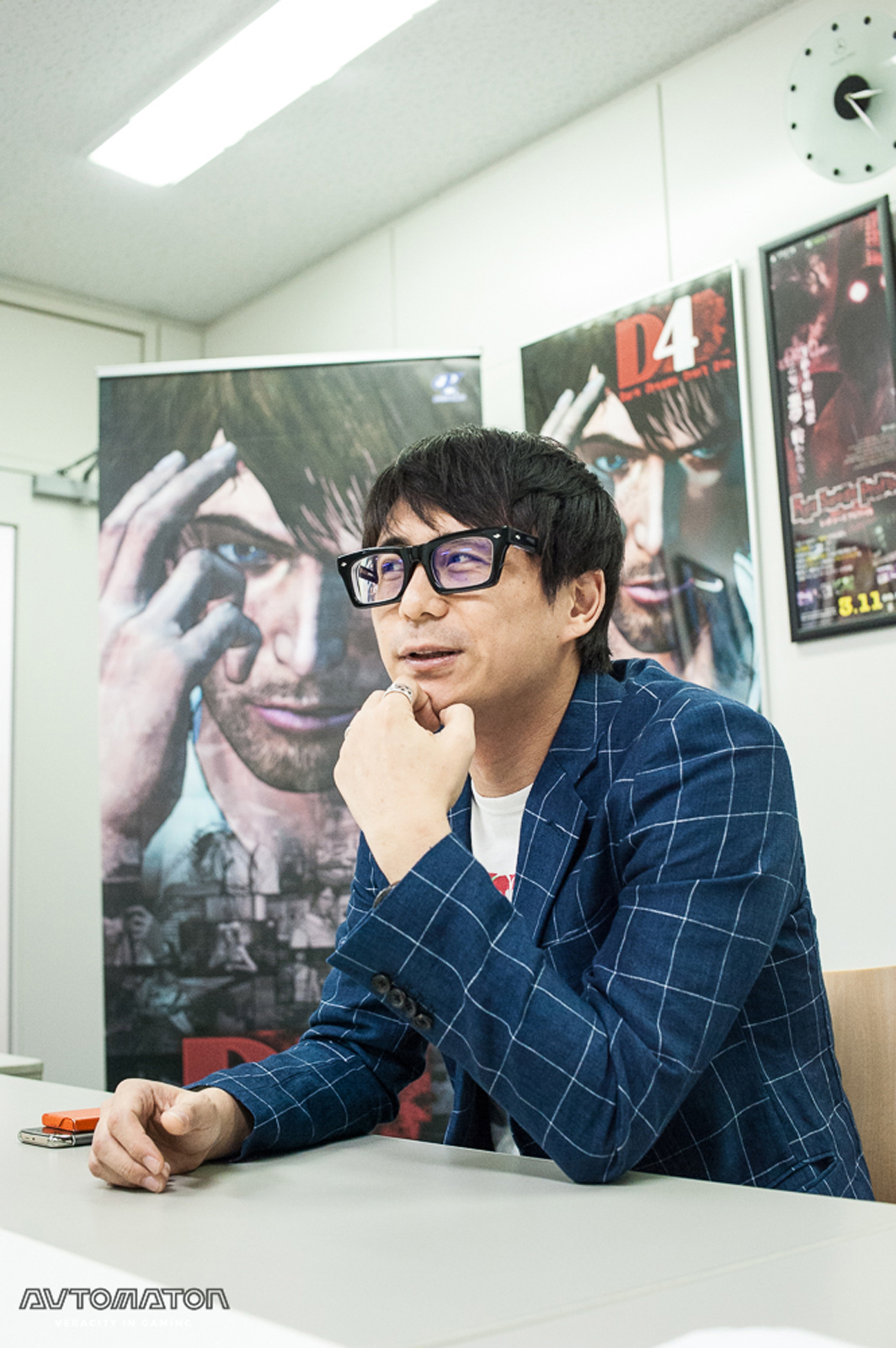
――So did you get a really big reaction from overseas fans?
SWERY:
Yeah, I had all kinds of people sending in comments over Twitter and email, and people coming up and talking to me at PAX and GDC, and that was a real source of encouragement as well.
――Did you get a lot of feedback and comments from fans for the PC version of Deadly Premonition, too?
SWERY:
Yeah. As for Deadly Premonition, not necessarily me myself, but the publisher actually got a huge response over that. First, I was asked if I would do a Director’s Cut version. But at that time, I was already making D4 and was super busy. The developer was a different company so I came on as a director and wrote up some extra additional scenarios, and yeah, that’s when I heard from the fans the most.
――Going back to the subject of the PC version, could you go over the differences between the PC version and the Xbox One version one more time?
SWERY:
There are a whole bunch of them, but going over the most characteristic differences, first off the Kinect was totally phased out. From there, we tuned the entire thing to work with mouse-based controls. And of course, we’ve reworked everything from the button response to the onscreen UI design to fit that. After that, for the PC version―and this is for those running on the recommended specs, but―we made it run at 60fps. It’s more clear than the Xbox One version, and I don’t know―it’s just a drama-based game, but it looks really nice and clear. Yeah. I don’t really know what it is, but I’m like “’60’ is really awesome,” you know?
I’ve played through the Xbox One version a lot, but stuff I didn’t notice at the time, like characters moving around in the background and swaying trees and the like, they’re so clearly visible now that you really notice it. That, and for the Xbox One version we had some DLC that was available for free for a limited time only, like clothes and costumes, and for the PC version these are all included from the get-go. We’ve retuned everything so that you can get a variety of in-game rewards by working on extra cases or going shopping.
Let’s see, what else… One more thing that’s specific to PC users that I actually learned after deciding to work with PLAYISM, was screen resolution and turning dynamic shadows on and off, stuff like that. I was told that those settings would be absolutely necessary for PC users, and I had no idea so we sort of rushed to add all of that in as well.
――I see, so that’s how that came about, then.
SWERY:
When making a consumer (console) title, you don’t need that kind of thing, you know? You just make the game appropriately for that specific hardware and that’s it. So I learned a lot from that.
――Backtracking a bit, you had mentioned that “sensory replication” couldn’t be tied down to one device. How was it actually retuning the controls from the Kinect to the mouse?
SWERY:
Well, since the game design itself of D4 really relies on being able to interact with the world inside the game and on really becoming the character, I made it so that instead of simply clicking the mouse cursor on things, you actually grasp something in your hand, or push something using your hand or whatever in order to get that sense of interaction. I’ve really tweaked even the subtle details, like adjusting the speed of your hand movements in conjunction with the cursor on the screen, and tweaking the range from which objects react when the cursor approaches, etc. For the Kinect, we used gestures for scenes with actions like swinging a bat or drinking tequila, but since we can’t use these gestures, in order to represent the force and speed at which the bat is swung and to make you want to swing it hard enough, we dropped in a large arrow marker, stuff like this. We’re using symbols to fill in those senses.
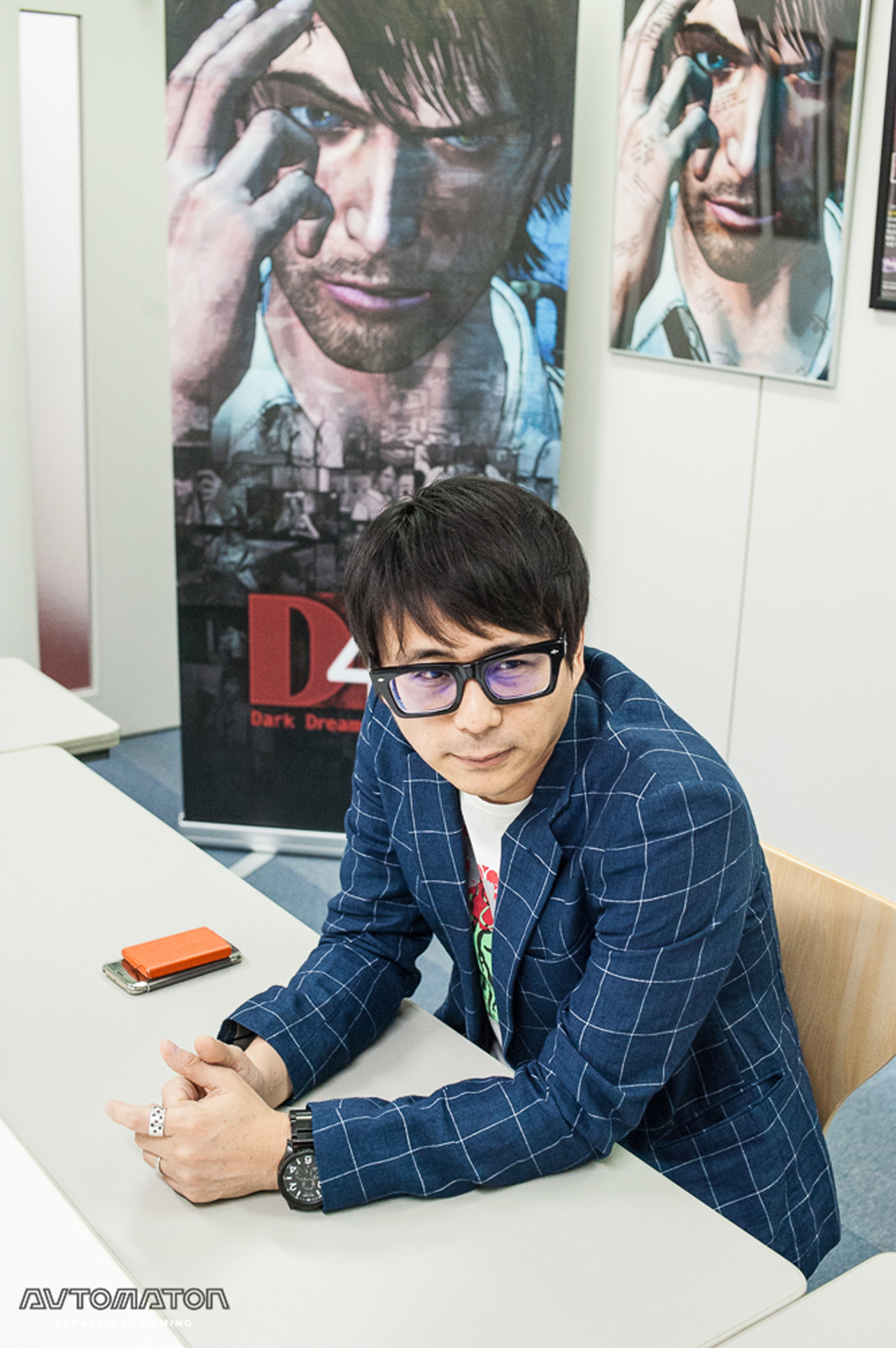
――On the PC, there are motion controllers such as Leap Motion and Kinect for Windows―do you have plans to make the game compatible with these?
SWERY:
Well, I think it would be possible, but we also have to consider the number of units actually in use, and so they’re currently not supported. Just yesterday, on Twitter someone said “Please make it compatible with a Wii U controller!”… Does the Wii U controller even work with Windows? I don’t really know…
――There are unofficial adapters available on the market.
SWERY:
Yeah, right? So anyway I received comments like that. And when I asked “For who?” the guy was like “For me!” [Laughs]
――[Laughs] Regarding D4, one more thing I want to ask is, do you already have solid plans in place for Season 2?
SWERY:
[Laughs] Um, well, there are a bunch of things all sort of overlapping, so right now I’m afraid I can’t actually help out with that. I guess all I can really say right now is to keep checking my Twitter feed to see what’s up.
――Word. So we’ll have to see what comes next: a new title, or D4: Season 2…
SWERY:
Well, we’ll see. I’m always doing new things, and I’ve been speaking with a lot of clients, and so it’s pretty hard to tell what will be coming up when, exactly. Some things will wrap up quickly, and other things could take years to complete. So I can’t really say anything specific.
[Interviewer: Shuji Ishimoto / James R. Mountain]
[Photographer: Mon Gonzalez]
この記事にはアフィリエイトリンクが含まれる場合があります。


